Posted by: Ken @ 3:51 pm
Having been born in the depths of the Great Depression, I acquired some habits of speech that are difficult to shed. I call the refrigerator an “ice box,” and the basement is the “cellar.” Our grandchildren enjoy correcting (ridiculing?) my speech. In my childhood, we made family excursions to visit the summer homes of friends and relatives on the New Jersey shore. Back then, I fed bread scraps to generic “seagulls” and chased generic “sandpipers” along the surf line.
When she was only three years old, our granddaughter spotted a bird flying over just as we were posing for a family photo at Disney World in Orlando. “Seagull,” I casually stated. “No, Grandpa, it’s a gull. there is no such thing as a seagull.” Proud to say, I taught her well, but still fail to practice what I teach. (Can you spot the two birdwatchers in the photo?)
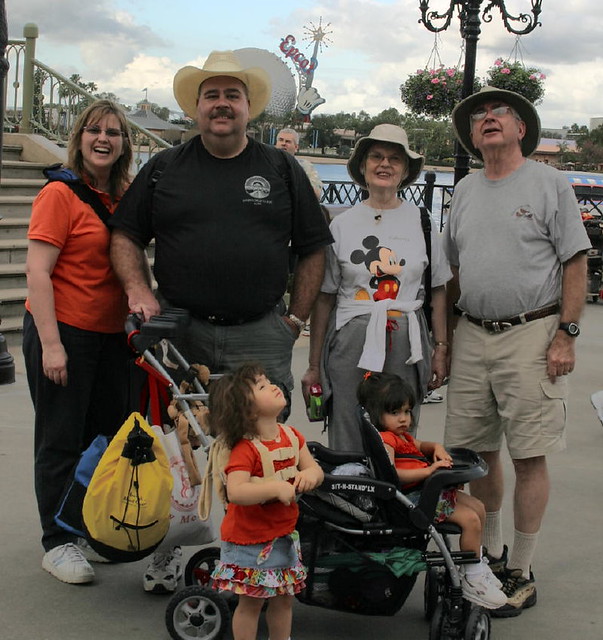
Granted, she had been pointing out and identifying birds from a very early age, and like a sponge, soaked up the birds’ proper names. Here she is, not quite two years old, correctly pointing out a House Sparrow.
Although I started keeping track of the birds quite early, my skills were initially limited to 20 or 30 of the common land birds in Chester A. Reed’s little pocket Bird Guide: Land Birds East of the Rockies (Doubleday, Page & Company, 1923).
The Guide did not include gulls and sandpipers. To me, it was as if they did not exist. When I graduated to a first edition Peterson Field Guide to the Birds, the small gray-scale illustrations of sandpipers and my inland residence contributed to my lifelong weakness in identifying these species.
“Sandpiper” meant those little robotic things that chased the foam from the breakers up onto the dry sand, and quickly reversed course to follow the foam back into the sea. At first I thought that sandpipers had eternally wet feet. Eventually I learned that this does not hold true all the time, and that some species are quite comfortable away from water for much of their lives.
Least Sandpipers, with their warm brown plumage and yellow feet, tend to favor the muddy edges of ponds.
The similar Semipalmated Sandpiper (with a much larger Yellowlegs in the background) has black legs and a gray back, and spends more time in deeper water.
The elongated shape of the Yellowlegs in the above photo suggests it is a Greater rather than the Lesser species, but the length and shape of its bill is a factor in identification. Here is a Greater Yellowlegs.
This is most likely an immature Lesser Yellowlegs, a bit smaller with a short, straight bill.
During a spring visit to Denali National Park I saw Greater and Lesser Yellowlegs, as well as Solitary, Spotted and Least Sandpipers on their breeding grounds on the tundra, quite removed from large bodies of water. Some perched in bushes, calling and singing like robins and sparrows. (Unfortunately, I had not yet taken up photography).
Around our condo in NE Illinois, temporary pools created by rainwater have attracted Solitary Sandpipers. This one appeared the morning after a heavy downpour.
Spotted Sandpipers stay to breed on the condo property long after the “fluddles” dry up. I photographed this one near our driveway, along the road, from inside our auto.
This past week, following up on reports posted to the Kane County Audubon Society website, Mary Lou and I made visits to a sod farm in Kaneville, Illinois and viewed from a gravel road that runs alongside its eastern border. Along the bare earth where sod had most recently been removed, we saw scores of Killdeer and Horned Larks and up to six Buff-breasted Sandpipers. They are quite handsome birds. This one approached quite closely.
We also saw four American Golden-Plovers, which like the Buff-Breasted Sandpipers*, breed in the Arctic tundra and migrate to southern South America. In fall, the plover must fly to its wintering grounds in Patagonia, a round trip of about 25,000 miles, including 2,400 miles non-stop over open ocean, one of the longest known migratory routes. Both species must build large stores of fat at stopover areas during migration, and their body weight may increase by 30-50% in preparation for the long flights.
American Golden-Plovers are uncommon but regular visitors to NE Illinois. (Click on this link for a video and more views)
I captured a Killdeer, a Buff-breasted Sandpiper and a golden-plover all in the same frame.
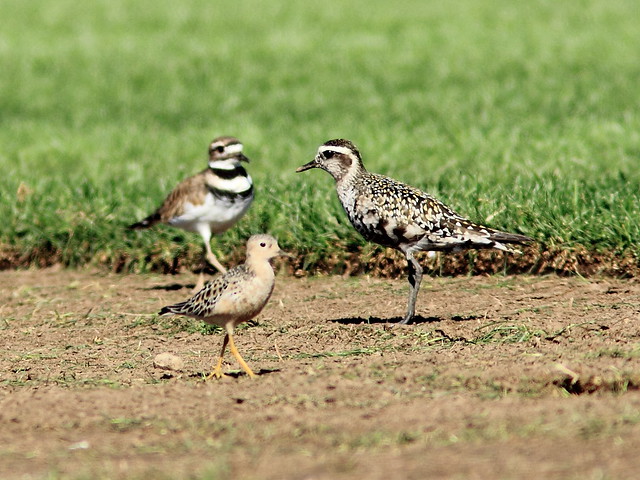
*More about the Buff-breasted Sandpiper from Wikipedia:
T. subruficollis breeds in the open arctic tundra of North America and is a very long-distance migrant, spending the non-breeding season mainly in South America, especially Argentina.
It migrates mainly through central North America, and is uncommon on the coasts. It occurs as a regular wanderer to western Europe, and is not classed as rare in Great Britain or Ireland, where small flocks have occurred. Only the Pectoral Sandpiper is a more common American shorebird visitor to Europe.
This species nests on the ground, laying four eggs. The male has a display which includes raising the wings to display the white undersides, which is also given on migration, sometimes when no other Buff-breasted Sandpipers are present. Outside the breeding season, this bird is normally found on short-grass habitats such as airfields or golf-courses, rather than near water.
















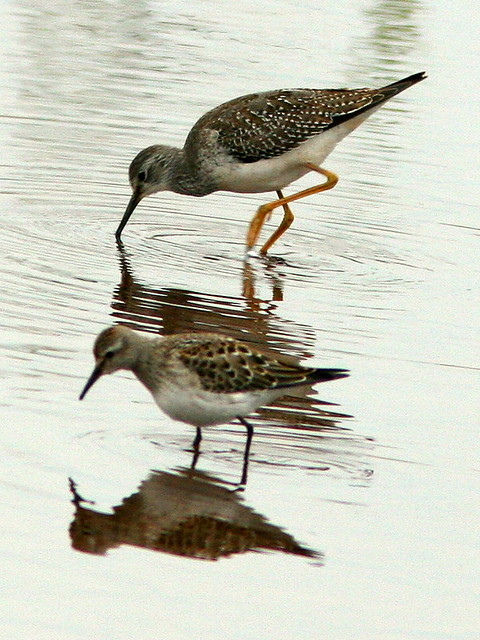
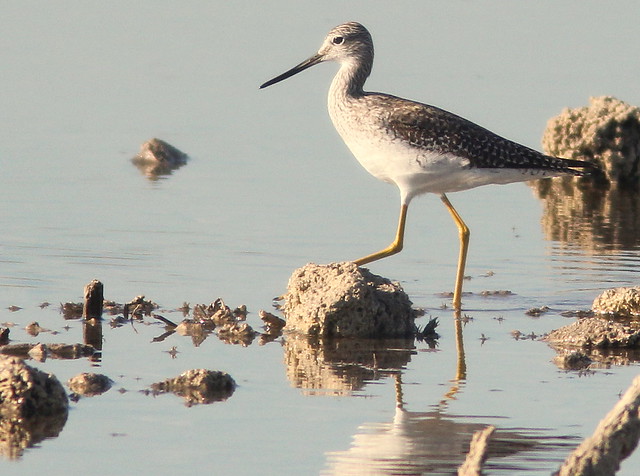
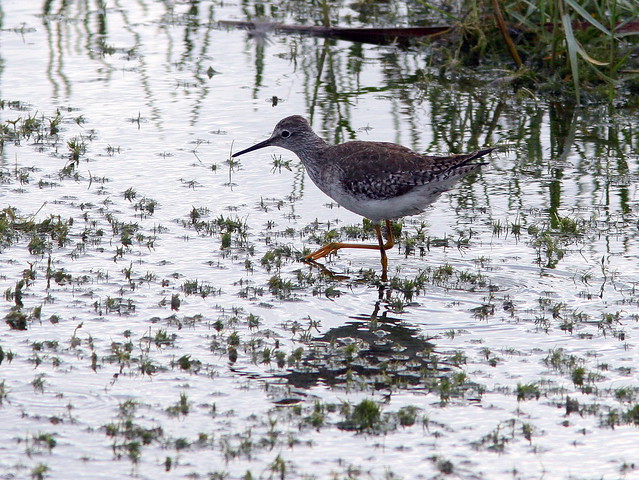


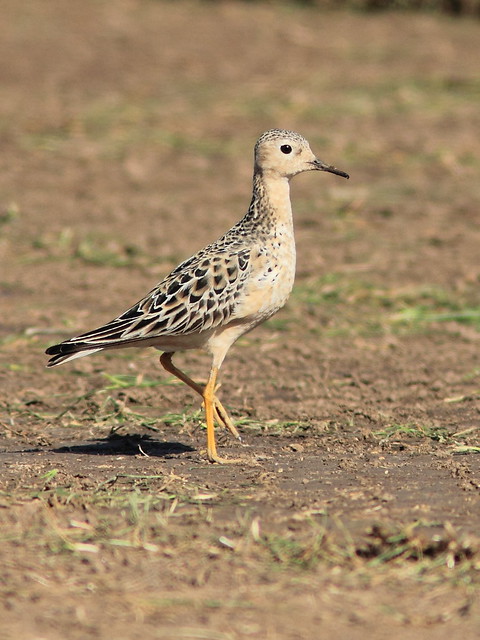
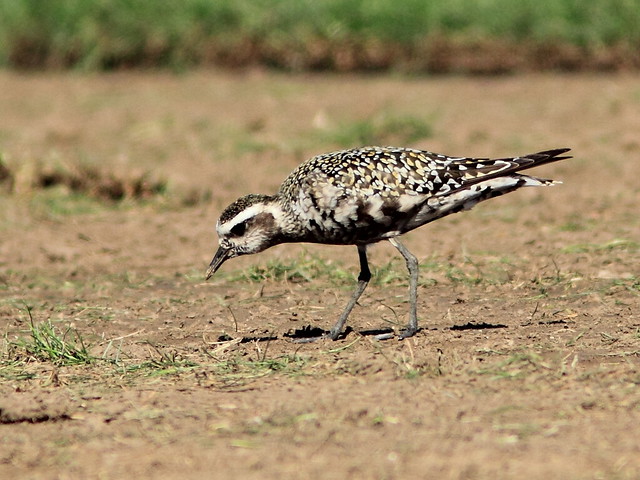
August 28th, 2012 at 10:52 am That doll face of a little gal….cute, cute, cute!!!! And your bird photos and commentary this time is super. I especially like the Solitary Sandpiper….the reflection…wow!!!
August 28th, 2012 at 11:19 am Great series, including the family. Boom & Gary of the Vermilon River, Canada.
August 28th, 2012 at 11:29 am your granddaughter made me smile. :) great shots of the plovers, sandpipers and yellowlegs! we will get a few shorebirds stopping here (lesser yellowlegs, snipe, etc.) but not too often.
August 28th, 2012 at 1:48 pm Very interesting descriptions and photos of all those sandpipers. The most interesting one to me is the American Golden Plover. It is a very rare visitor down here and not easy to distinguish from the Pacific Golden Plover in non-breeding plumage.
August 28th, 2012 at 3:09 pm loved the plovers; great photos you shared here today
August 28th, 2012 at 3:32 pm Ken, these are wonderful. I love the family shot and your cute granddaughter - the young birder. Is she keeping a life list already? Beautiful birds, the last shot is one of my favorites. Great post and photos.
August 28th, 2012 at 5:41 pm Lovely post, superb photos! You must be very proud of your granddaughter’s expertise at identifying birds.
August 28th, 2012 at 5:59 pm Stunning shorebird photos, Ken! Some wonderful reflections, too! Well done!
August 29th, 2012 at 5:58 am Beautiful images of your wonderful birds..
August 29th, 2012 at 6:11 pm Gorgeous shots of the birds Ken! That last photo with the three species in one frame is awesome. I am also partial to the Buff-breasted Sandpiper and American Golden-Plover shots, both of which would be lifers for me! But, the photo of your granddaughter pointing at the birds is adorable!
August 30th, 2012 at 6:16 am Great set of pictures - all of birds I’d like to see! My kids try to make me say “seagull” (it hurts even to type it!) all the time - rascals! Thanks for linking to WBW - Stewart M - Australia
August 30th, 2012 at 8:34 pm Great series love the one with all three different species in it.
August 30th, 2012 at 11:40 pm Nice pictures of some beautiful birds. Hanne Bente
September 5th, 2012 at 2:43 pm @eileen, your link is bad, but no, my granddaughter does not yet kep a formal list. She does know quite a few birds. Thank you, all, for your kind comments!